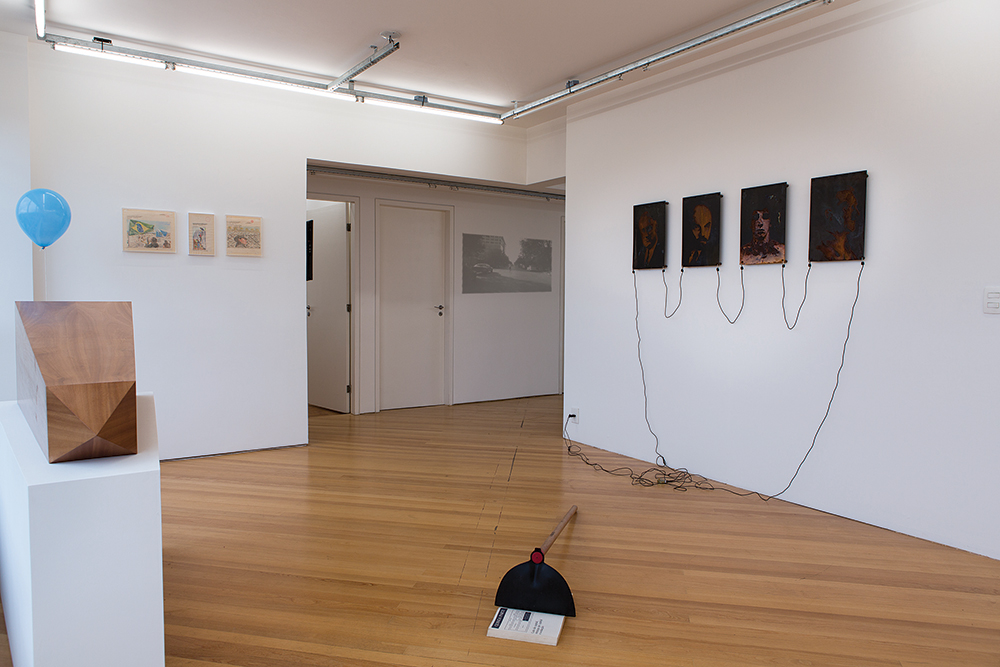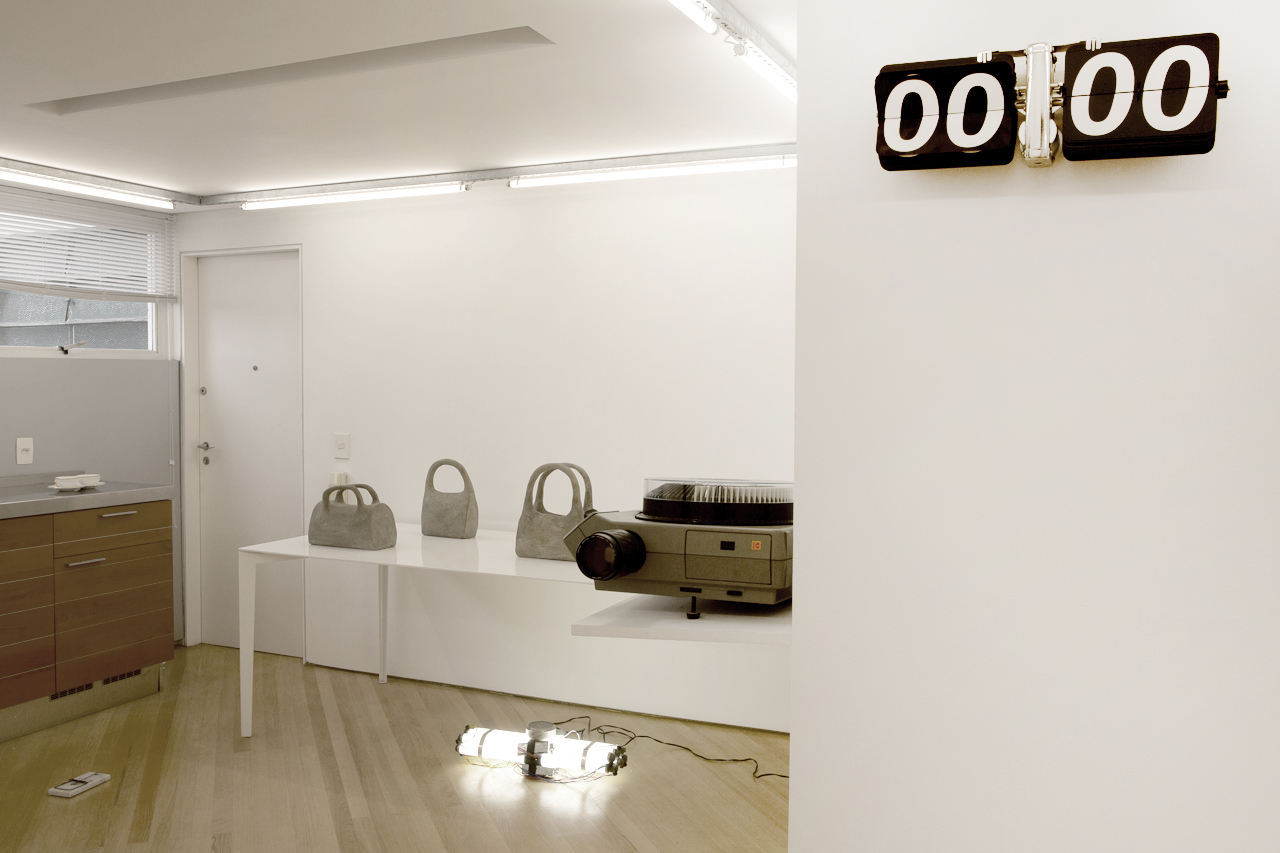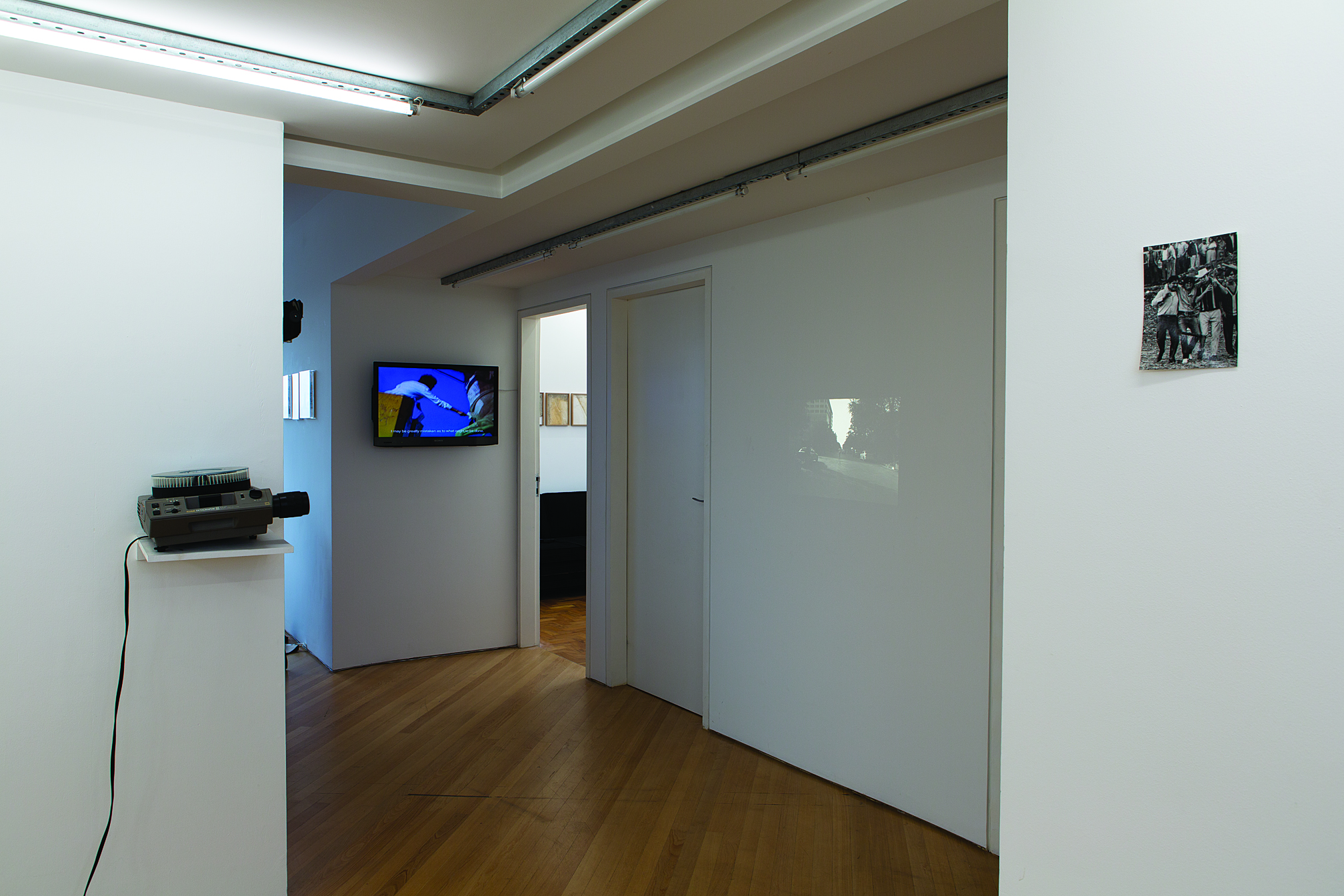At Stake
Curated by Olivia Ardui

Board games involve two or more players that progress according to specific rules on a flat and marked surface, a board. Despite their apparent playfulness, these games can be interpreted as scenarios where tactics are chosen in order to win. This aspect of competition and its strategic dimension justifies symbolic readings of board games that can be understood as an analogy of society. Among board games, chess epitomizes this kind of analogy. In fact, when introduced in Europe around the 10th century, its rules were set so that they mirrored the power relations and the codes that regulated the feudal system.1
In spite of the historical distance that separates us from the medieval times, chess is nevertheless still a relevant metaphor to refer to present socio-political conflicts. Indeed, the principle of the game resembles the dynamics of a globalized world that works like a
giant chessboard wherein (un)declared struggles take place for strategic positions, natural resources or zones of influence. However, the game often develops to the detriment of some individuals who, resembling pawns, are at the mercy of imposed rules that often compromise their physical, moral, or emotional integrity.

The exhibition At Stake gathers artworks – the majority coming from the moraes-barbosa collection2 – that analyze and question the rules behind the global chessboard, often emphasizing the multiple implications they can have on people's lives. The expression “at stake” signifies putting something at risk or being placed in a critical situation, inducing it into a stalemate, such as in chess when a player has no apparent moves left. For example, we may say that a natural disaster puts millions of lives at stake. In a broader sense, to put something at stake also induces us to question it, doubting its significance, pertinence or value. This second meaning of the term, being more than an effective danger, implies that the integrity of institutions, principles and established ideas are at issue. This comprehension of the expression refers thus to a skeptical and even subversive approach. The artworks showcased in At Stake are articulated around this expanded understanding of endangerment and contestation.

Skepticism seems to underlie a first nucleus of works, more specifically, a defiance regarding conventional and codified representations and recognizable icons. Some typologies of images have long histories and are constituted by arbitrary forms interrelated to official narratives, ideologies and values and thus, by extension, to the “rules of the game” that govern our society. Monuments, for example, are structures erected by communities to commemorate events and notable actions or to honor public figures and are representative of the people's comprehension of their own history.
Far from being neutral, monuments narrate a history shaped by sociopolitical positions. In the video On Education, by Amalia Pica, the action of painting in white the horse of an equestrian statue may suggest an association between an official conception of history
and the white horse of folk tales, in which besides the epic and heroic tone, the narrative is developed in a very simplistic and manicheistic way.

Skepticism seems to underlie a first nucleus of works, more specifically, a defiance regarding conventional and codified representations and recognizable icons. Some typologies of images have long histories and are constituted by arbitrary forms interrelated to official narratives, ideologies and values and thus, by extension, to the “rules of the game” that govern our society. Monuments, for example, are structures
erected by communities to commemorate events and notable actions or to honor public figures and are representative of the people's comprehension of their own history.
Far from being neutral, monuments narrate a history shaped by sociopolitical positions. In the video On Education, by Amalia Pica, the action of painting in white the horse of an equestrian statue may suggest an association between an official conception of history
and the white horse of folk tales, in which besides the epic and heroic tone, the narrative is developed in a very simplistic and manicheistic way.

This iconoclastic violence is evident in Monument [Monument], by Clara Ianni, a piece composed of a hoe that appears to cut a financial administration manual in half. The juxtaposition of a tool of manual labor with the theoretical quality of a book invests the two objects with a symbolic charge, making an indirect reference to the socialist and capitalist imaginary. Louis Vuitton voyage avec Karl Marx et nous voyageons avec Louis Vuitton [Louis Vuitton travels with Karl Marx and we travel with Louis Vuitton ], by Carlos Garaicoa, also constitutes a visual paradox associated with incompatible ideologies: a red book with a photograph of Karl Marx, detractor of consumption culture and of the bourgeoisie, is partly inserted into a Louis Vuitton purse, one of the ultimate
luxury brands. From this paradox, the piece suggests how the content of a book can be emptied and integrate the very system that it criticizes by turning into a commodity, just like any book bought in a newsstand.
In a way, Paulo Nazareth also evokes this question of decontextualization and emptying of meaning in his series Imagens que já existem no mundo [Images that already exist in the world]. In this group of works, the artist redraws images found in newspapers during his pilgrimages for “Paulo Nazareth arte contemporânea LTDA” [“Paulo Nazareth Contemporary Art LTD”], clearly indicating that the works are destined to be sold as “Brazilian art.” The puerile dimension of the drawings does not correspond to the urgency and gravity of the represented topics – a police raid in Rio, Mexican immigration to the United States, or even the presence of China in Brazil.
Guilherme Peters, in Autorretrato com Roosevelt, Lenin e Hitler [Self-Portrait with Roosevelt, Lenin, and Hitler], presents a gallery of portraits, induced by the oxidation of iron plaques interconnected as to create an electric current. This device accentuates the corrosion of the plaques, mirroring the functioning of collective memory, that progressively erases and blurs the subject depicted, pointing to the growing distance between historic facts and their representations. In contrast with the conventional official portraits that denote force and power, the artist is the only anonymous figure in this gallery of effigies, represented frontally and with a type of framing similar to the parameters of identification documents.
The dissonance between individual and collective is even more palpable in a second group of works in which the individual, much like a pawn on a chessboard, is at the mercy of a larger entity, the real adversary in the game match. In this case, the individual finds himself in a critical situation caused by a physical and/or moral threat, sometimes with their lives and integrity at stake.
This seems to be the case of Shot of Grace with Alighiero Boetti Haircut Style (Kabul), by Mario García Torres, consisting of a succession of slides evoking a scene of persecution. The rhythm and dynamism of the projection are countered by the similarity of the
images that reiterate the same composition and a fixed camera: the artist, turning the back to the camera, and thus apparently moving away from it, is running in the center of a street in Kabul. incessantly escaping of an unidentified danger. If we understand “shot” in the sense of a photographic act, the title can also refer to death, but in the sense of interrupting the flow of life by freezing an instant in time. In both cases, however, neither the artist nor the camera changes position, thereby perpetuating, from slide to slide, the suspense of the imminent fall of the fugitive.
If in the work of Mario García Torres raises the expectation of the decisive moment of capture, in Untitled by Fernando Ortega, this moment seems to happen in fact. The photograph represents an anecdotic episode in which two men carry a third man that appears to have hurt his left knee, in which the artist inserted a nail, and fixing him to the wall.
The leitmotif of flight is present in Bags by Rayyane Tabet, but this time, relative to the specific context of the civil war in Lebanon and how this hampered the everyday life of its population. The piece evokes a common practice in that period consisting in leaving suitcases and bags ready in case it became necessary to flee or leave for exile. With a simple and poetic gesture, the artist condenses all of the tension of a people in imminent danger: he cements bags of his mother and other people he knew, visually translating the specific connotation that these objects acquired during the civil war. If the bags normally facilitate travel, the omnipresence of possible displacement turns them literally into heavy and oppressive objects.
Similar to this idea of bags that are impossible to carry, Mona Hatoum's Tea for Two compromises the functionality and utility of an object by manufacturing a double cup. In order for two people to really drink from this double cup, there needs to be extraordinary
coordination and concession, what way allude to the forced “marriage” between Israel and Palestine, from where her parents are from. Alongside the allusion to escaping in the precedent artworks, other pieces more explicitly incorporate or suggest imminent danger. This is suggested by Abuso de poder [Abuse of Power], an ivory mouse trap by Marcelo Cidade, and by Big Bum [Big Boom], a neon light time-bomb by Cinthia Marcelle.
The anxiety about the passage of time and its interruptions of this last piece also permeates some other works that punctuate the exhibition. In Untitled, Nicolás Bacal literally depicts inertia and temporal suspension: a clock containing only its second hand - the one corresponding to the counting of the seconds, the smallest unit of temporal measurement - is attached to a helium balloon so that the linear and chronological progression of time is countered.
In Timeless by Theo Craveiro, the course of the second hand is also interrupted, but this time by a hand that holds it back. In Untitled, a digital clock by Rivane Neuenschwander where all of the platelets that compose it are inscribed with zeroes. In this way, despite the periodic movement of the device, the clock continuously shows zeros, as if there were no change in time.
This immobility and apparent lack of action also underlies Unspoken Dailies by Mario García Torres, a video recording of the actor Diego Luna reading a conference paper written by the artist a few years prior wherein he discusses Bas Jan Ader and his concept of the “unspoken”. The text is read silently by the actor before it is to be destroyed. Therefore, the text only exists in the memory of the actor and in the intangible register of his reading, while a clock marks the inevitable passing of time.
The tension between immobility and the promise of movement, a situation in suspense, an impasse. A last group of works showcased in this exhibition address situations of impasses occasioned by external factors, international relations and, in particular, the geopolitics of oil. This resource has changed profoundly the history of the regions rich in it, and whether openly or covertly, it has justified conflicts and the fall of regimes, population exodus and even the appropriation of territory.
The reference this natural resource is evident in Perigo, Perigo... [Danger, Danger...] by Jimmie Durham, consisting of an oil barrel with a sign indicating “Danger”. The piece suggests that this element, ubiquitous in our surroundings, is often extracted a the cost of the labor or the displacement of existing communities, namely numerous Native Americans that were evicted from their original land.
Found Paper consists of a series of A4-size sheets of paper with letterhead from the Trans-Arabian Pipe Line Company (TAPLine) – a pipeline that would have linked Saudi Arabia with Palestine. These sheets of paper were never used but still ended up being marked by the passage of time. With the diverse conflicts that reached the region, the route of the pipeline was altered many times to ultimately divert from Palestine to Lebanon, a move that was partly responsible for the economic development of the country. Rayyane Tabet rescues these torn and deteriorated sheets of paper from the ruins of the TAPLine, melancholic vestiges of an ideal of integrated politics and economics between different countries of the region and that could have, in the end, considerably changed its dynamics.
The greed for oil is omnipresent in Chronoscope, 1951, 11pm by Alessandro Balteo Yazbeck in collaboration with art historian Media Farzin. The video consists of a montage of fragments from a North American program that was transmitted between 1951 and 1955 and was titled Longiness Chronoscope. The show brought specialists together to debate political situations, happenings, and current affairs. The chosen sections in the work all relate to North American reactions to the nationalization of Iranian oil, reactions that focus on how this move poses a threat to U. S. economic interests in the region. The montage also suggests similarities with the discourse of fear and threat that is still being conveyed by the media of this country, in particular after September 11.
This tense relation between the United States and a few countries of the Middle East also is one of the premises of Instabilidade Perfeita (Pacific Standard Time – Arabic Standard Time) [Perfect Instability (Pacific Standard Time – Arabic Standard Time)] by Roberto Winter. More specifically, the artist makes reference to a moment of diplomatic crisis created by the leakage of confidential documents, including images of North American soldiers bombing civilians in Iraq. A copper plaque folded and engraved with Roman numerals suggests a clock that indicates the exact time in which Chelsea Manning3, an army specialist in information technology, confessed to have released some secret information to the website WikiLeaks. The clock indicates the exac time of this confession, which was made to Adrian Lamo, a man with whom Manning corresponded and who shortly after denounced him to the FBI. Manning was imprisoned in 2010 and stayed without a trial until 2013, when she was condemned to 35 years in prison.
Despite chat being an interface that is easily falsifiable, this was used as the only evidence of Manning's high treason. This situation brings to the surface ethical questions about an individual's position in relation to political and military conjunctures. Ultimately, it may seem that we are all marionettes submitting to a will that exceeds our power. This will can be of an economic or geopolitical nature, but also social and familiar, as suggests Eva Kotatkova with her collages of the series Not how people move, but what moves them. Based in family photos – in different sizes and in black and white – the artist delicately scratched the collage in such a way so as to appear that the individuals are being imprisoned by each other or are connected by cords manipulated by others, as in a theater of marionettes.
Just as in a board game, social, economical and political apparatus will always be determined by rules, with all the power relations and hidden interests that this implies. The artworks selected for the exhibition At Stake incite reflection and make us adopt a critical distance towards the issue put “at stake”.
---------------
Artists:
Nicolás Bacal
Alessandro Balteo Yazbeck
Marcelo Cidade
Theo Craveiro
Jimmie Durham
Carlos Garaicoa
Mario García Torres
Mona Hatoum
Clara Ianni
Iman Issa
Eva Kotatkova
Cinthia Marcelle
Paulo Nazareth
Rivane Neuenschwander
Fernando Ortega
Guilherme Peters
Amalia Pica
Rayyane Tabet
Roberto Winter